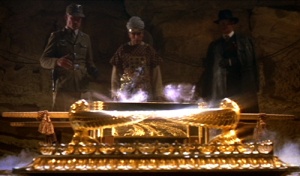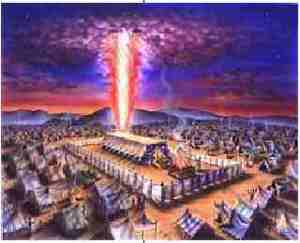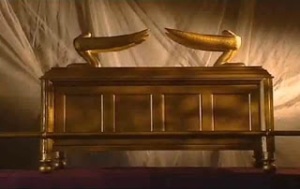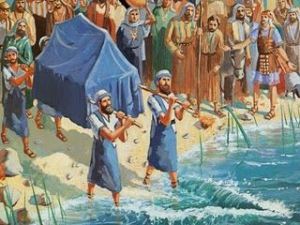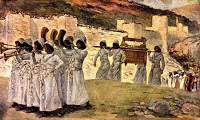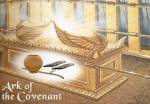The (Lost) Ark of the Covenant … Part I
Where is the Ark of the Covenant? What happened to it? Will it ever be found? Or has it already been found, having never been lost … just secretly secured for a special time such as rebuilding the Jewish Temple? How often have those questions been asked? How many religious and secular archeologists, treasure hunters, museum curators, history buffs, and amateur sleuths have spent an inordinate amount of time researching archives, watching documentaries, reading books and articles, or expending a great deal of money on archeological expeditions to faraway places in passionate pursuit of one of the greatest and most remarkable relics of all time?
Millions upon millions have been mesmerized by one of the most captivating, thrill-a-minute adventure movies ever made, Raiders of the Lost Ark. Written and produced by George Lucas, and directed by Steven Spielberg; starring Harrison Ford, Karen Allen, John Rys-Davies with villains played by Paul Freeman and Ronald Lacy. Released in August, 1981, it spawned three more Ark movies with each title name preceded by its main character, Indiana Jones. But none of the sequels rivaled the original, whose real protagonist and centerpiece was the Ark of the Covenant … an archeological find that men would die for.
Who can ever forget the stunning finish in which the French archeologist Belloch, working for the Nazis, defiantly opens the Ark? Extraordinary special effects depict streams of laser-like light and underworld spirits that engulf and obliterate all those present who would dare disturb and profane this holy artifact by even staring at it. All, of course, but Indiana Jones and his lady companion, Marion.
Those of us who know most Scriptural events fairly well fully realize that Hollywood’s Bible storytelling rarely is accurate, and often exceeds even poetic license in creating a movie around a Biblical event, person, place, or thing—in this case the Ark of the Covenant. Oh, there have been a couple of exceptions, such as Cecil B. DeMille’s Ten Commandments starring Charlton Heston, which is fairly true to what actually happened.
For example, Indiana Jones’ idea of not looking at the ark after it was opened apparently combined the Biblical demise of Lot’s wife when she, against the angel’s orders, looked back at the destruction of Sodom, with the divine but deadly powers that the Lost Ark contained. Obviously, the actual Ark of the Covenant, itself, did not possess mystical powers. But the Nazis didn’t know that. They believed that wielding the Ark in battle would make their armies invincible, and they spared no cost in finding it. Still, we are left wondering whether the Ark itself was capable of such power, or whether it was divine judgment that annihilated the bad guys.
Those who have studied the Biblical account and the attributes of God fully understand that it was the God of the Ark who alone possessed divine power, the kind that would assure success for the Jews as long as they trusted and obeyed The Lord. As long as they realized that the Ark itself was not some magical chest that protected the Israelites or powered them to victory no matter whether the Israelites obeyed the Lord or not.
I suppose that Raiders of the Lost Ark could take some creative liberty with how and where the Ark was found, as today’s Ark scholars acknowledge that no one knows for sure where it is or how it got to wherever it is. And, for others, whether it even (still) exists or not. However, for the Staff of Ra (Egyptian sun-god) to be used to discover the location of the Ark in Egypt, specifically in the Well of Souls, is adding a totally pagan element to what is otherwise a sacred part of Biblical history. Though this Staff that lined up the sun’s rays created suspense, the movie totally ignored some of the more realistic places where the Ark may be kept, such as the most often suggested location … beneath Temple Mount or somewhere in Jerusalem.
But there is one spectacular scene in that grand finale of this absorbing movie that just might (accidentally … I’m sure the producer, screen writer, and director didn’t make this connection) depict or represent what happened to or could have happened to the Ark of the Covenant. I’m referring to the ark being lifted from its resting place into the sky on what was portrayed as a divine supernatural beam of light; then pausing in the air, and plummeting back to the earth at exactly the place where it had been catapulted upward, followed by the ark’s cover slamming downward in perfect place over the ark again.
Keep that thought in mind as this week’s and next week’s articles delve into the compelling and true story of the Ark of the Covenant.
The Purpose for the Ark of the Covenant
Why was it built? What was God’s plan and intended use for it? Why is it the most precious sacred object in all of Judaism? And, almost equally captivating to a great many Gentiles. Why does it still generate reverence and spellbinding intrigue with so many people, especially the Jews? Why do so many people desperately want to find it; or, at least to know that it still exits and where it might be kept? First, we need to take a look at the title of the Indiana Jones movie, Raiders of the Lost Ark.
Perhaps the producers of this blockbuster movie, that some classify as the greatest action-adventure film of all time, elected to omit of the Covenant—after Raiders of the Lost Ark—in order to emphasize the Lost aspect of the Ark; or to make the title shorter and more marketable and appealing. Or, they may have felt it wasn’t necessary to describe it any other way except the (Raiders of the) Lost Ark. For whatever reason, they didn’t include the most important feature and Biblical significance of its description, which is: The Ark of the Covenant.
The Ark of the Covenant was built for and first placed in the Tabernacle, then later in Solomon’s Temple. But there are several expressions or designations in Scripture: The Ark; The Ark of the Covenant; The Ark of the Lord; The Ark of God; The Ark of the Covenant of the Lord; or The Ark of the Lord’s Covenant. But most frequently: The Ark of the Covenant. When God first instructed Moses to build this holy implement of worship, it was referred to as just an ark. But once the Lord explained the Ark’s purpose and place, it was nearly always: The Ark of the Lord or the Ark of the Covenant.
First came the construction of the Tabernacle. Here are God’s instructions to Moses: “Have the people of Israel build me a holy sanctuary so I can live among them. You must build this Tabernacle and its furnishings exactly according to the pattern I will show you” (Exodus 25:8).
This was utterly amazing!
The God of Israel (of the entire universe) had rescued his people from Egyptian bondage by magnificent miracles and supernatural power, and had led them through the wilderness in the cloud by day and pillar of fire by night. But the Lord’s plan far exceeded deliverance. First, he gave them Divine Law and standards to live by. Then, God told Moses and the Israelites that he would actually live among them—in the wilderness and when they entered and occupied the Promised Land which God had already bequeathed to them through Abraham, Isaac, and Jacob as an eternal possession. Of course, the people’s sojourn in the wilderness should have lasted only a year. Because they disobeyed God by not trusting him, they spent forty long, arduous years in the desert. But God was with them the entire time.
However, the Tabernacle, a holy sanctuary was to be built for God to dwell amidst the people, to separate a perfectly Holy God from a not so holy people. Periodically, God had visited and had even spoken with a handful of his chosen people; but never before had God actually or permanently dwelled with mankind. This was an astounding development … God’s very presence within the camp of Israel.
Note: Obviously, the Lord didn’t then nor ever will need a physical structure in which to be present with his people. God is Spirit and is Omnipresent (everywhere at any time). He did so in Moses’ time for the benefit of the Israelites, so they could better understand that he was the true and living God. A personal God who personally knew them, not some faraway detached being who was essentially oblivious to human beings. And to better comprehend and appreciate how much he cared for them and wanted to bless them … wanting the best for them. That they would literally be one nation under God, the ultimate Divine Theocracy with the perfect, powerful, but loving and benevolent Sovereign Monarch. The Lord God, himself!
Then God instructed Moses to build something even more unusual, as God’s holy presence and glory (his very essence displayed visually) must be shielded from the people, with the eventual exception of the high priest once a year and Moses, himself, whom God chose to speak with, “face to face.” Hence, the Ark of the Covenant. But even these exceptions required God to cover his glory with dense smoke or clouds. God is Light, pure light … both literally and spiritually. Which is one of several reasons he gave us his one and only Son, who took on human flesh, as the express image of God. So we can see all the attributes of God in one man—Messiah Jesus.
God told Moses: “Have the people make an Ark of acacia wood—a sacred chest 45 inches long, 27 inches wide, and 27 inches high. Overlay it inside and outside with pure gold…” (Exodus 25:10-11). More instructions followed.
After the Ark was built, God said: “Place inside the Ark the stone tablets inscribed with the terms of the covenant, which I will give to you. Then put the atonement cover on top of the Ark. I will meet with you there and talk to you from above the atonement cover between the gold cherubim that hover over the Ark of the Covenant. From there I will give you my commands for the people of Israel” (Exodus 25:21-22, italics for emphasis).
Remarkable! Not only did the Ark literally contain the Ten Commandments, which were also a symbolic representation of the entire Covenant of the Law, it included a top enclosure that was called the Atonement Cover or the Mercy Seat, where once a year all of Israel’s sins would be forgiven when the high priest offered the required animal sacrifices … blood shed for remission of sins. Moreover, God, himself, was right there to accept the sacrifice and personally assure that the atonement offering was sufficient for a complete pardon that year. Most Jews still observe the Day of Atonement, Yom Kippur … minus the blood sacrifices that is so all important.
But there was more: The Ark of the Covenant had to be placed in the inner sanctuary which was so holy that it needed to be separated from the rest of the interior of the Tabernacle/Temple. It was separated by a beautifully designed and intricately woven curtain. Then God told Moses to: “Hang the inner curtain from clasps, and put the Ark of the Covenant in the room behind it. This curtain will separate the Holy Place from the Most Holy Place. Then put the Ark’s cover—the place of atonement—on top of the Ark of the Covenant inside the Most Holy Place” (Exodus 26:33-34). The Most Holy Place is also called the Holy of Holies.
Thus, in these passages and a few others, we see the primary purpose for the Ark of the Covenant and the special sacred place where it was to be kept. (1) The ultimate place of Atonement where God dwelled among his people, faithfully bestowing his marvelous grace and mercy that forgave the sins of every individual in Israel, but also on a national level. The cover of the Ark of the Covenant was, indeed, the Mercy Seat of God. (2) The physical housing of the Ten Commandments, which was also a symbolic affirmation of the Law Covenant between God and Israel.
The Power of the Ark of the Covenant
Later the Ark of the Lord’s Covenant was carried by the Levite priests ahead of Joshua and the nation of Israel when they first crossed the Jordan River into Canaan. What happened during this crossing was a miracle every bit as impressive as the splitting of the Red Sea that enabled the Hebrews to escape the Egyptian onslaught. With one major difference: During the parting of the Red Sea, God’s presence and power was symbolized by Moses’s staff and the divine cloud and pillar of God. With the triumphant passage through the Jordan River and glorious entrance into the long-awaited Promised Land, it was the Ark of the Covenant that represented God’s presence among his people and assurance of victory over their enemies.
Let’s read the phenomenal account: “So the people left their camp to cross the Jordan, and the priests who were carrying the Ark of the Covenant went ahead of them. It was the harvest season, and the Jordan was overflowing its banks. But as soon as the feet of the priests who were carrying the Ark touched the water at the river’s edge, the water above that point began backing up a great distance away… And the water below that point flowed on to the Dead Sea until the riverbed was dry. Then all the people crossed over near the town of Jericho” (Joshua 3:14-16).
After all the people had crossed and even more time elapsed to build a stone memorial to this stupendous event, the priests finally stepped out of the dry riverbed. “As soon as the priests carrying the Ark of the Lord’s Covenant came up out of the riverbed and their feet were on high ground, the water of the Jordan returned and overflowed its banks as before” (Joshua 4:18). Once again the passage mentions the Ark, this time, The Ark of the Lord’s Covenant, to emphasize and spiritually clarify the fact that it was the Lord their God who did all this, not merely the Ark.
Which is the real essence of the Ark of the Covenant … it was not some magical chest that contained mystical power. Rather it was the Ark of the Lord’s Covenant that God had sealed with Israel, and all the blessings and promises that the Covenant provided.
And who doesn’t remember what happened just a few days later: Sing the tune in your head or aloud: And the walls came tumbling down! It was one of the most lop-sided battles, one of the most providentially guaranteed victories of all time. Yes, the Israelites had to some fighting, but the implication is very little combat, as the battle was all but over when the inhabitants of Jericho witnessed their indestructible walls falling like dominoes all around them. All the Israelites had to do was walk around the city … good exercise don’t you think!
I’m sure the Israelites and even Joshua were perplexed at their “marching orders.” But they listened to and obeyed the Lord without question. They trekked around the city for six days, then seven times on the seventh day. On cue with the blare of the trumpets, they gave a loud shout to end all shouts.
“…Suddenly, the walls of Jericho collapsed, and the Israelites charged straight into the town and captured it” (Joshua 6:20).
But we sometimes forget a vital part of the story; once again the Ark of the Covenant was carried by the priests and prominently displayed both to the Israelites and to their enemy. The battle of Jericho is found in Joshua Chapter 6 and the Ark of the Covenant is mentioned no less than nine times, most often referred to as, The Ark of the Lord. This to underscore that the Ark was more than just the Ark of the Covenant; it was a tangible illustration of the Lord, himself … his provision, protection, presence, and most of all in this instance, his awesome power.
To me, an even more remarkable event took place just before the Battle of Jericho. We read it in the last verses of Chapter Five. “When Joshua was near the town of Jericho, he looked up and saw a man standing in front of him with sword in hand. Joshua went up to him and demanded, ‘Are you friend or foe?’ ‘Neither one,’ he replied. ‘I am the commander of the Lord’s army.’ At this, Joshua fell with his face to the ground in reverence. ‘I am at your command,’ Joshua said. ‘What do you want your servant to do?’ The commander of the Lord’s army replied, ‘Take off your sandals, for the place where you are standing is holy.’ And Joshua did as he was told” (Joshua 5:13-15).
Incredible! I firmly believe that this man was none other than the Pre-Incarnate Messiah … one of several Pre-Incarnate appearances of Jesus Christ. We know he was (is) God, because he told Joshua the same thing that God the Father told Moses from the burning bush—take off his sandals, for this was holy ground. What (Who) made it holy? Answer: God’s very presence. What did the Commander of the Lord’s army require of Joshua? Only one thing: To remove his sandals which was obedient recognition that he was in the presence of God (through the Pre-Incarnate Christ); therefore, that God was with him and would win the battle for Joshua and all of Israel. With supernatural power no less than demonstrated against Pharaoh and the Egyptians; as God, from the holy ground of the burning bush, told Moses would happen.
From that point on, the Ark of the Covenant was seen by Israel as not only where the presence of God dwelt (in the Tabernacle), but as a source of divine power … particularly in battle. So much so, that, as Israel began to fall away from the Lord to the extent of worshiping false gods, they wrongly and foolishly concluded that as long as the Ark of the Covenant was with them, God would be with them. The legend of the Ark of the Covenant became so well-known that even Israel’s mortal enemy, the Philistines, believed that the Ark contained mysterious powers that equaled or surpassed their own gods.
But lest we think that this was just an ancient superstition that has long since faded, the Third Reich of the 20th century went to great lengths searching for religious objects the world over that could help them win the war. With the warped idea that (their equally perverted version of) God would be on their side. First and foremost among these relics was the Ark of the Covenant. In that regard, the agenda of the Nazis and the French Archeologist, Bulloch—finding the Ark of the Covenant in the movie Raiders of the Lost Ark—was an accurate depiction of what was taking place before and during World War II. That alone highlights the intensity of those who seek the Ark of the Covenant, both bad guys and good guys.
What Happened to the Ark of the Covenant?
In next week’s article we will examine more history of the Ark of the Covenant, including its capture by the Philistines, recovery and removal of the Ark to Jerusalem, incidents in which improper and unauthorized contact with the Ark resulted in the death of Israelites, and the destruction of Solomon’s Temple by the mighty Babylonian Army. Which is essentially the last we see or hear about the Ark of the Covenant.
We will also look at theories about where the Ark of the Covenant was taken and kept to this very day.
When the Romans destroyed Herod’s Temple in 70 AD, the Jews lost the all-important sacrificial system that was such an integral part of the Covenant of the Law, epitomized by the Ark of the Covenant. What has Judaism done or become to compensate for such a heart-rending loss?
Please refer to the Eye of Prophecy three-part series entitled, Where is the Temple? Published 11-29-14, 12-6-14, and 12-13-14, respectively. These articles present this profound question for and dilemma of the Jewish people. And then provide the reason why their all-important sacrificial system (along with the Ark of the Covenant as covered in this current two-part series) is gone; and, accordingly, was not meant to be permanent because of the New Covenant prophesied by God through his prophets.
Today in the 21st century, the passionate anticipation of the Jews for the coming Messiah is reaching a fever pitch. As is their ardent desire to rebuild the Temple, and return the Ark of the Covenant to its rightful resting place in the inner sanctuary of the Temple. Included in that earnest expectation is the belief by many observant Jews that the Ark of the Covenant still exists and that its location is known by some.
The Jews have anguished over the loss of the Temple for nearly 2000 years. Likewise, with the Ark of the Covenant, because the two are virtually inseparable. If one doesn’t concur with the incredible impact and importance of the Temple and the Ark of the Lord, they only need look at what is going on in Israel today. Among all the differences between the Arabs and the Jews, the most conspicuous and insurmountable difference is Jerusalem. Even more so, Temple Mount. Observant Jews are determined to rebuild the Temple, reinstitute the sacrificial system preferably with the Ark of the Covenant. The Arabs are equally set on making sure that this doesn’t happen.
So what happened to the Ark and where is it today? Very few, if any, believe it was destroyed or lost … meaning so lost that no one will ever find it. Most, especially observant Jews, believe that it still exists, with many saying it remained in Jerusalem … hidden in some secret cave or vault beneath the city. Can it be found? Still others say that question doesn’t need to be asked or answered; because they are absolutely positive that the Ark of the Covenant is resting in a secure place and will be restored to the 3rd rebuilt Temple.
Things to Ponder:
As a prelude to Part II of this two-part series, we need to consider that if the ark had been hidden and protected in a safe place, then certainly Scripture would have mentioned that in some fashion, i.e. that the Ark of the Covenant had been preserved from destruction by the Babylonians. In no less fashion than the Bible telling us that Moses died, but that God buried him and no one (to this day) knows the location of Moses’ grave.
The Ark of the Covenant is such a monumentally significant and integral part of the Old Testament, it’s unthinkable that the Bible would not inform us as to its disposition. If not its location, then at least evidence that it was not destroyed or lost.
Also, we must ask ourselves this probing question: If the ark had been secured, then why wasn’t it brought to and placed in the 2nd Temple, which was built just some seventy years after Solomon’s Temple was destroyed? That’s only one generation. Some Jews of that generation would have known where to find the Ark. But the fact remains: The Ark of the Covenant was never placed in the Holy of Holies of the 2nd Temple.
This makes it very difficult to accept the prevailing consensus that the location of the ark is known by a few and will be placed in the rebuilt 3rd Temple. The 2nd Temple stood for over 500 years, without the Ark of the Covenant. Why wasn’t the Ark ever returned to the Temple, no matter where it had been taken?
Yet, Scripture doesn’t leave us completely clueless. There are two passages, one Old Testament and one New Testament reference, that gives us indirect; but nevertheless, logical, feasible, and deductively conclusive evidence. So much so that I am going to announce a very startling premise:
Premise: We can, with a great deal of Biblical certainty, know what happened to the ark and where it’s located!
But you’ll need to tune in to next week’s Eye of Prophecy article to find out.
I’ve already given you a strong clue … the movie scene in which the Ark of the Covenant rises above the earth, then sets down again.

